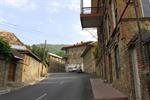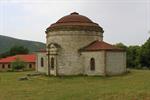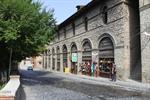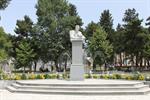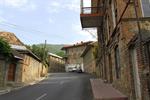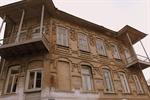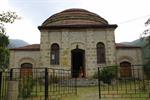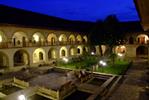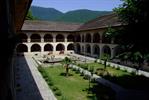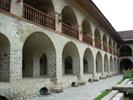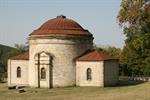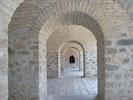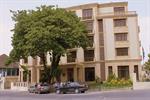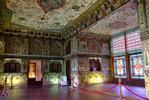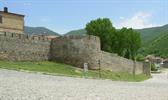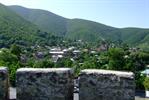Snoozing amid green pillows of beautifully forested mountains, Sheki is one of Azerbaijan's loveliest towns. It has a rich history and is one of the few places in the country where tourism can be described as even vaguely organised. Even so you probably won't see more than a handful of fellow travellers here, even during summer.
History
There are traces of the large-scale settlements in Shaki that date to more than 2700 years ago.
According to the Azerbaijani historians, the name of the town goes back to the ethnonym of the Sakas, who reached the territory of modern day Azerbaijan in the 7th century B.C. and populated it for several centuries. In the medieval sources, the name of the town is found in various forms such as Sheke, Sheki, Shaka, Shakki, Shakne, Shaken, Shakkan, Shekin.
The Sakas were an Iranic people that wandered from the north side of the Black Sea through Derbend passage and to the South Caucasus and from there to Asia Minor in the 7th century B.C. They occupied a good deal of the fertile lands in South Caucasus in an area called Sakasena. The city of Shaki was one of the areas occupied by the Sakas. The original settlement dates back to the late Bronze Age.
Shaki was one of the biggest cities of the Albanian states in the 1st century. The main temple of the ancient Albanians was located there. The kingdom of Shaki was divided into 11 administrative provinces. Shaki was one of the important political and economic cities before the Arab invasion. But as a result of the invasion, Shaki was annexed to the third emirate. An independent principality was established in times of a weakened Arabian caliphate. The city was also ruled by Georgian Kingdom, Atabegs of Azerbaijan and Khwarezmid Empire before Mongol invasion.
After the collapse of the Hulagu Khan's rule in the first half of the 14th century, Shaki gained independence under the rule of Sidi Ahmed Orlat. Shah Tahmasp put an end to the independence of Shaki in 1551 and annexed it to Safavid Empire with brief periods of Ottoman rule in 1578–1603 and 1724-1735. Shaki Khanate was established in 1743, and was one of the strongest feudal states among the Caucasian khanates. During existence of Shaki khanate, the local population of the city was engaged in silkworm breeding, craft and trade. As a result of a flood in the river Kish, the city of Shaki was partially ruined and the population was resettled in the present day city. The Shaki khanate became a vassal of the Russian Empire in accordance with the second Treaty of Kurakchay of 1805.
The area was fully annexed by Russia by the Treaty of Gulistan in 1813 and the khanate was abolished in 1819 and the Shaki province was established in its place.
During its history, the town saw devastation many times and because of that, the oldest historic and architectural monuments currently preserved are dated to only the 16th-19th centuries. For many centuries, Shaki has been famous for being the center of silkworm-breeding.
Historic Sheki was originally higher up the valley around the site now occupied by Kish. That town was ruined by floods in 1716 but rebuilt by rebellious Khan Haci Celebi, who set up a defiantly independent khanate there in the 1740s. He built a second fortress at Nukha (today's Sheki). When the original Sheki was obliterated a second time by more catastrophic floods and mudflows in 1772, Nukha became the new royal capital and the capital of Shaki Khanate. As the new location was near the village of Nukha, the city also became known as Nukha, until 1968 when it reverted back to the name Shaki.
The khanate was ceded to Russia in 1805 but Nukha continued to flourish as a silkweaving town and an important traders' junction where the caravan route between Baku and Tbilisi met the cross-mountain branch route to Derbent in Dagestan. At its peak there were five working caravanserais here. Nukha was renamed Sheki in the 1960s.
Nowadays, Sheki is likely the most visited city in Azerbaijan, by both local and foreign tourists. Its setting, among the oak tree laden hills, means the weather is generally more comfortable here than other parts of the country. On top of which, there are a few notable attractions to see while in town.
Orientation & Information
The main square is an attractive park full of teahouses 1.6km north of the bus station. The old town starts around 1km further northeast up MF Axundov kuc. A steep cobbled lane continues 400m up from the Karavansaray to the fortress walls. Within lies the Xan Saray (Khan's Palace). Sheki extends almost all the way to Kish village, 6.5km north through the suburb of Dodu. There are several currency exchanges, ATMs and slow Internet Klubs around the main square.
SIGHTS
Within the fortress walls
The sturdy stone perimeter wall of Haci Celebi's Nukha Fortress today encloses an 18th-century palace, several museums and a decent cafe-restaurant, all set in patches of grass that are kept mown by flocks of sheep.
The Shaki Castle which was built by the founder of the Shaki Khanate Haji Chelebi Khan (1743–1755), near the village of Nukha on the southern foothills of the Caucasus. The fortress walls are close to a thousand and two hundred meters long and over two meters thick. Protected by numerous bastions, the fortress is entered by two main gates from the north and south. At the height of the khanate, the fortress contained a gated palatial complex and public and commercial structures of the city, while the residential quarter was situated outside its walls. It was restored extensively between 1958 and 1963. Many years Shaki fortress safeguarded approaches to the city, the acts of bravery by its defendants of fight with foreign oppressors had been written in many history books. In Leo Tolstoy's well-known Hadji Murat novel, Sheki fortress had selected as place of events.
Xan Saray
Sheki's foremost 'sight' is the two-storey Sheki Khan Saray (The King's Palace), which was finished in 1762. It is located just up the hill from the Caravansaray, with a decent view over the city and is set in a walled rose garden behind two huge plane trees supposedly planted in 1530. The walled grounds (free entry) hold several building all belonging to the one time Khan of the land, and various other occupying forces. There are couple of museums that are generally not recommended for visit.
The stunning exterior of the Palace is masterfully decorated with dark blue, turquoise and ochre tiles in an array of geometric patterns, magnificently setting off the intricate wood-framed, stainedglass windows known as shabaka. You'd think that alone would be a reward, but it's TOTALLY worth it to pay the 2 manat (or so) to go in the Palace. A skillful tour guide (no extra charge) shows you around the fabulous interior, explaining the meaning of the magnificent murals, which cover the walls and even the ceilings. Easily one the most impressive building in Azerbaijan that you could see.
Only one-room deep, the palace's interior is surprisingly petite. However, virtually every square inch is covered with extraordinarily colourful murals. These reach a climax in the central upstairs apartment which vividly features the heroic battles of Haci Celebi, complete with requisite swords, guns and gory severed heads. The 'lady's room' to its right (as you face the window) is contrastingly pastoral, decorated with flowers, birds and arabesques.
The ‘lord’s room’ to the left has more ‘manly’ scenes of hunting, mythical beasts, and lions ripping antelopes to pieces. If you arrive after 6pm or want to see the fasade in glorious golden sunset light, the guard might sneak you in for whatever he thinks you’re prepared to pay.
Museums
Shaki hosts a wealth of historical museums and some of the most important in the country. The Shaki History Museum is one of the main museums, considered one of the most important for artifacts of the Khanate period.
Tour groups are marched dutifully around the Rashidbey Afandiyev Historical-Regional Ethnography Museum, whose name is more impressive than its exhibits: archaeological oddments, ethnographical artefacts and the usual emotive panels on WWII, Karabakh and the Xocali massacre. Across the road is a late-19th-century Russian church in unusual cylindrical form, built on the site of a 6th-century Caucasian Albanian original. It now hosts the limited Museum of National Applied Art that displays fairly haphazard collections of Sheki crafts, including metalwork, pottery and embroidery. Hardly worth the money.
More interesting is a Shabaka Workshop (admission free; 9am-7pm), where local craftsmen (no English) assemble traditional stainedglass windows, slotting together hundreds of hand-carved wooden pieces to create intricate wooden frames without metal fastenings. Small examples are sold as souvenirs.
As of 18th century, five big Caravanserais (Isfahan, Tabriz, Lezgi, Ermeni and Taze) were active in Sheki but only two of them have survived. The upper and lower Caravanserais were built in 18th century and used by merchants to store their goods in cellars, who traded on the first floor, and lived on the second. Both Caravanserais includes view of all convenience and safety of merchants and their goods
OLD TOWN
Even if you don’t stay here, peep inside the wonderful Karavansaray (MF Axundov kuch), an historic caravanserai with a twin-level arcade of sturdy arches enclosing a pretty central courtyard. A caravansary was a roadside inn in years gone by. A place for wary travellers to rest and eat. Caravansarys supported the flow of commerce and information on trade route stretching from Asia to the Middle East to Eastern Europe. This large 2-storey example has been superbly rebuilt to reflect it's former glory. Rooms are simple, but all have western toilet and hot water.
The historic atmosphere of the hotel is certainly worth the modest 30 Manat per room. Even if you decide not to stay here, the tea garden is great way to experience the culture and still great some great photos of the hotel. Stride through the somewhat daunting wooden gateway door and if questioned say you're heading for the restaurant in the garden behind, a lovely place for a cuppa with a slice of Sheki's signature halva (pastry with nuts).
Immediately downhill is a second, even larger but partially ruined 19th-century caravanserai. Beyond, Sheki's old town follows
a canalised stream down towards the main square passing a pair of 19th-century mosques, numerous halva shops and a chess school with interesting metal reliefs on its outer walls. An appealing maze of red-tiled roofs and shady lanes lies behind.
Shopping
The expansive Taza Bazaar sells pottery, metalwork and carpets, as well as masses of fresh fruit, vegetables, meat and cheese. Saffron is a bargain at just 50q a pouch. Get there by southbound minibus 11, 8 or 5. Sheki still has a working silk factory(kombinat) 50m west of upper Rasulzade kuc. It doesn't allow tourist visits but opposite the entrance its store, Ipek Magazin (9am-6pm), sells attractively simple silk scarves from AZN10.
Climate
Shaki is surrounded by snowy peaks of the Greater Caucasus, in some places reaching 3000–3600 m. Shaki's climate includes a range of cyclones and anticyclones, air masses and local winds. The average annual temperature in Sheki is 12 °C. In June and August, average temperature varies between 20 and 25 °C.
The mountain forests around the area prevent the city from floods and overheating of the area during summer. The main rivers of the city are the Kish and Gurjhana. During the Soviet rule of Azerbaijan, many ascended to Shaki to bathe in its prestigious mineral springs.
Getting There & Away
There are several useful services from the bus station (Rasulzade kuc). For Baku via Ismayilly and Shamaxa, marshrutkas (seven hours) depart approximately hourly between 6.30am and 5pm or later, supplemented by big buses around midnight. A shared taxi costs AZN12 per person. Sheki train station is a whopping 17km south of town. A nightly train to Baku departs around 10pm but you can't always count on getting a ticket for same-day departure.
Getting Around
Sheki sprawls over a very large area but there's a usefully extensive network of marshrutkas. Bus 22 shuttles past the bus station, passes the southeast corner of the main square and rolls up to the Karavansaray and fortress area. However, it's fairly rare and from the bus station it's best to cross Rasulzade kuc, turn right then walk one block north to the corner of Hamidov kuc. From here frequent marshrutkas 8 and 11 (both starting at Taza Bazaar) turn left and head for the central square. The 11 continues to the Karavansaray and passes near the Xan Sarayi. The 8 goes on past the Silk Factory and terminates at the Makan Motel in Dodu.
From the train station to town, a single marshrutka (60q) meets incoming trains but fills fast. Taxis cost AZN3. Alternatively, walk 700m east and flag down passing northbound transport from the AzPetrol junction.
If you're planning a trip to Azerbaijan you may be interested ▶ Azerbaijan highlights - For those who prefer to go unbeaten path, to explore less visited places and check national charisma of this small country in Southern Caucasus on the edge of Europe.



